EARLY
JAPAN (13,000 BC - 710 AC)
# During the Jomon Period (13000 BC to 300 BC), the
inhabitants of the Japanese islands were gatherers, fishers and hunters.
# During the Yayoi Period (300 BC to 300 AD), social classes started to evolve, and
country began to unite under powerful land owners.
# The emperor was ruler of
Yamato Japan (400AD) and resided in a capital that was moved frequently from
one city to another.
# In 645, Nakatomi no Kamatari started the era of
the Fujiwara clan that was to last until the rise of the military
class (samurai).
 |
| Replica of Jomon Period subsistence activities |
 |
| Pottery from Yayoi Period |
NARA AND HEIAN PERIOD (710 - 1185)
# The first
permanent Japanese capital was established in Nara, a city modelled after the Chinese capital.
# One characteristic of the Nara and Heian periods is a gradual
decline of Chinese influence which, nevertheless, remained strong. Many of the
imported ideas were gradually "Japanized".
# The Fujiwara family controlled Heian period over several
centuries through strategic intermarriages with the imperial family and by
occupying all the important political offices in Kyoto and the major provinces. 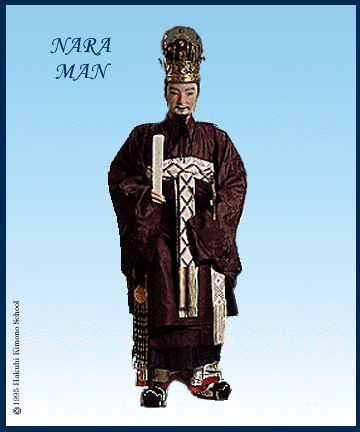 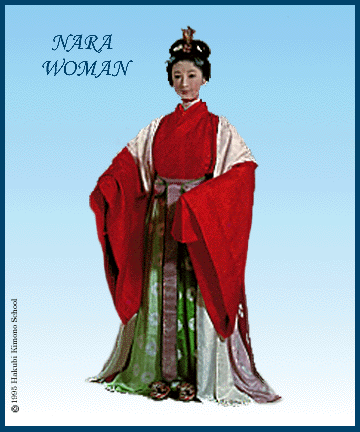
Man and woman clothing during Nara Period that
influenced by Chinese
KAMAKURA PERIOD (1192 - 1333)
# Chinese influence continued to be relatively strong during
the Kamakura period.
# New Buddhist sects were introduced, found
large numbers of followers among the samurai (shogun), which were now the leading social class.
# Hojo clan regents were able to bring several decades
of peace and economic expansion to the country until an external power began to
threaten Japan.
Samurai class (shogun) ruled over Kamakura Period
MORUMACHI PERIOD (1333 - 1573)
# Two imperial courts existed in Japan for over 50 years:
the Southern and Northern courts. They fought many battles against each
other.
# The Southern court gave in in 1392, and the
country became emperor-wise reunited again.
# In 1542, the first Portuguese
traders and Jesuit missionaries (Jesuit Francis Xavier) arrived
in Kyushu, and introduced firearms and christianity to Japan.
# Despite Buddhist opposition, most of the Western warlords welcomed
Christianity because they were keen in trade with overseas nations mainly for
military reasons.

A ship of Morumachi Period

Kinkaku-ji or Zen Buddhist Temple, an excellent
example of Morumachi Period garden design
AZUCHI-MOMOMAYA PERIOD (1573 - 1603)
# Oda
Nobunaga (a samurai) achieved control over the province of Owari
(around the modern city of Nagoya) in 1559. He succeeded in capturing the capital in
1568.
# Toyotomi Hideyoshi, a general fighting for Nobunaga, reacted
after Nobunaga death, and took over control.
# After uniting the country, Hideyoshi conquered China.
However, they were pushed back again by Chinese and Korean forces in the
following year.
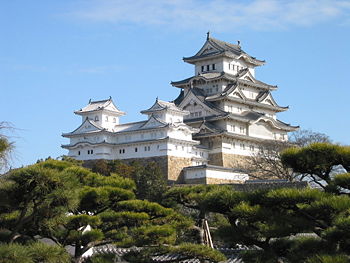
Azuchi Momoyama Castle. Build in 1333-1346;
destroyed and rebuild 1580; major expansions 1601-1608

Oda Nobunaga statue in front of JR Gifu Station
EDO PERIOD (1603 - 1867)
# Ieyasu was appointed by the emperor and established his government in Edo (Tokyo). The Tokugawa shoguns continued to rule Japan for 250 years.
# The top of the social hierarchy stood the samurai, followed by the peasants, artisans and merchants. Outcasts, people with professions that were considered impure, formed a fifth
class.
# In 1867-68, the Tokugawa government fell because
of heavy political pressure, and the power of
Emperor Meiji was restored.
 
Kabuki
Dance (traditional theater) developed
during Edo Period
MEIJI PERIOD (1868 - 1912)
# The new government aimed to make Japan a
democratic state with equality among all its people. The boundaries between the
social classes of Tokugawa
Japan were gradually broken
down.
# After about one to two decades of intensive
westernization, a revival of conservative and nationalistic feelings took
place, increasingly emphasized and taught at educational institutions.
# Conflicts of interests in Korea between China and
Japan led to the Sino-Japanese War in
1894-95. Japan defeated China and received Taiwan.
# New conflicts of interests in Korea and
Manchuria, this time between Russia and Japan, led to the Russo-Japanese
War in 1904-05.

Meiji Emperor who brought
modernization and democracy of Japan
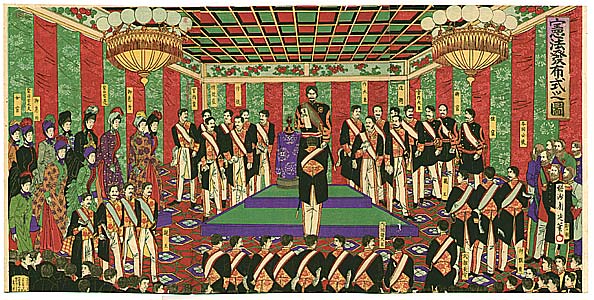
Meiji Emperor and new constitution
TAISHO AND EARLY SHOWA PERIOD (1912 - 1945)
# After WW1, Japan's economical situation worsened. The Great Kanto Earthquake of 1923 and the world wide depression of 1929
intensified the crisis.
# In July 1937, the second Sino-Japanese
War broke out. However, the
Chinese government never surrendered completely, and the war continued until
1945.
# In December 1941, Japan attacked the Allied
powers at Pearl Harbour and was able to expand her control over a large
territory.
# In 1944, intensive air raids started over Japan.
In spring 1945, US forces invaded
Okinawa in one of the war's
bloodiest battles.
# Emperor Showa finally decided to surrender
unconditionally after US military forces dropped two atomic bombs
on Hiroshima and Nagasaki on
August 6 and 9.

Farthest limits of Japanese conquests in World
War 2

Asahigara heavy cruiser carrying troops from Batavia to Singapore during World War 2

Mushroom cloud over Hiroshima city
after being dropped by atomic bomb
|
POSTWAR PERIOD (SINCE 1945)
# After World War II had ended, Japan was devastated. All the large cities (with exception of Kyoto), the were severely damaged. A severe shortage of food continued for several years. # A new constitution went into effect in 1947: The emperor lost all political and military power, and was solely made the symbol of the state. # With the peace treaty that went into effect in 1952, the American occupation ended. The recovery of Japan's economy flourished. The economic growth resulted in a quick rise of the living standards. # Japan's relations to the Soviet Union were normalized in 1956, the ones to China in 1972. # The 1973 oil crisis make Japanese shift to high technology industries. 
Hiroshima Peace Memorial Park: Ceremony held here
every August 6 and the moment of silent at 8.15 am
(exact time
the bomb was detained)

The image of Japan, 69 years after World War 2 ended
|




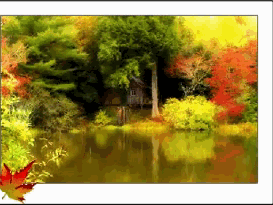


No comments:
Post a Comment